Wooden surfaces in the house are strongly associated with quality, environmental friendliness, comfort. However, often the natural advantages of wood are offset by low-quality varnishes and paints. Alas, but many companies primarily think about profits and not their customers.
Sistema LLC is a pleasant exception to the rule. Since its foundation in 1997, the motto of our employees has been the phrase "customer first". We are confident that strong partnerships based on mutual respect and the search for the most optimal solution to problems are the key to success in business. That is why Sistema LLC introduces a coating of unique quality to the market - a water-based varnish for wood.
home distinguishing feature of this material is its absolute environmental friendliness. The water base does not contain harmful substances. This allows you to safely use it in places with increased environmental safety requirements. For example, children's rooms, kitchens, baths, saunas. Yes, and just in the house of those for whom the "health of loved ones" is not an empty phrase.
What is water based wood varnish?
Water varnish is a mixture of water, binders and other special components. Unlike the usual types of varnishes, the preparation of the mixture is vaguely reminiscent of the work of a baker. In the form of an algorithm, the preparation of varnish looks like this:
- Emulsifiers are poured into the water base (sifted similarly to flour).
- The resulting substance is kneaded until a homogeneous state. Appearance at this stage is very similar to dough.
- A solvent is added to the resulting substance, which is responsible for the formation of the outer film.
Depending on the type of delivery, varnishes are sold as two-component mixtures or, as in the case of Iruxil SBA-6000 varnish, one-component composition, which is ready for use.
The impact of such varnishes also has its own specifics. It is divided into three stages, each of which emphasizes the unique properties of wood.
The film-forming solvent begins to dry. At this stage, an outer protective layer is formed and the structure of the wooden product is emphasized.
Final drying with the formation, depending on the type of varnish, of a glossy or matte surface. At the same time, the tree partially “breathes”. This effect is unattainable with conventional varnishes.
Advantages and disadvantages of water-based varnishes.
Water-based varnish for wood is significantly superior in performance to all other types of coatings. In particular:
- It is easy and safe to apply. The varnish is non-toxic at all stages of preparation;
- The coating has excellent adhesive properties on wood.
- The resistance of aqueous varnishes due to deep penetration is better than traditional coatings.
- The varnish dries quickly, which makes it possible to start using the products soon.
- Due to the special composition of the varnish is not flammable.
- Water varnishes protect the wood from the spread of fungus, pests, bacteria.
Critics, of course, also name shortcomings. Most often they appeal to the need for transportation at positive temperatures and the issue of price.
Indeed, the water base of the varnish requires special treatment. And buying such coverage from an incompetent seller can turn into a disappointment. In the case of working with our company, this is excluded.
Thanks to our approach to business, we have won the right to represent the products of the Spanish company "IRURENA" (IRURENA) - one of the leaders among the manufacturers of coatings in Europe.
And, offering unique products, we, of course, know all its advantages and disadvantages. As for the monetary issue, direct contracts with the manufacturer guarantee the absence of numerous "intermediary" surcharges in the price. Taking care of our customers, we make even elite materials affordable. See for yourself.
Product Catalog.
IRUXIL SBA-6000 - One-component water varnish for external finishing of joinery.
IRUXIL W-E - Water azure for processing all types of wood, designed for outdoor and indoor use. Emphasizes the structure of wood. Available in several basic colors. Prevents darkening. It has protective properties against atmospheric precipitation, ultraviolet radiation, insects, rot and fungal infections.
Spring has come and with it come new worries and new work.
Therefore, it is in the spring that tips on how to apply water-based wood varnish are so relevant and useful. You agree with me?
After all, right now our wooden houses and furniture in them need our care so much, and we need advice and help in how we can make this repair.
I am sure that in this article we will answer a lot of questions and give you the advice you need.
Tips on how to apply water-based wood varnish:
1. First you need to prime the wooden surface. Priming should be done with a special water primer. Or tinted impregnation. This will not only reduce the consumption of varnish, but at the same time will allow you to get a smoother top coat.
2. What needs to be done to get a "mirror" coating. First, the wet sanding method should be used before priming. The wood must first be wetted with water. Then let it dry well.
3. Sand each layer with very fine sandpaper. Except for the very last top layer. This will help to get a very smooth, mirror-like surface.
4. If the surface to be painted has defects or irregularities, then the varnish must be chosen correctly. Glossy will emphasize these defects, and matte will hide them.
5. Also, water varnish can be used to update an already previously painted surface. But in this case, the previous varnish layer must be sanded and degreased with an aqueous solution of soap.
6. Important! To dilute water varnish, you need to use only clean water! Do not add organic solvents to it.
7. Do not mix water-based varnish with other varnishes based on different solvents.
8. And one more piece of advice. Do not mix water varnish with drying oil.
9. If you opened a can of tinted varnish and saw that it had a different shade on top. Don't be afraid and don't worry! This varnish must be thoroughly mixed before use. Then the color will become uniform and distributed throughout the volume.
10. Do not dilute the varnish with water by more than 10%. This usually leads to a deterioration in the structure of the wood.
11. If you need to dilute the varnish with water, then mix varnishes of different shades. And always count on the fact that it is enough for the entire product. It will be a shame if the paint is not enough. You risk getting a completely different shade of the surface.
12. At low air humidity it is not necessary to carry out paint and varnish work. At humidity below 50%, the varnish dries very quickly. And this can also lead to swelling of the painted surface or other defects may occur.
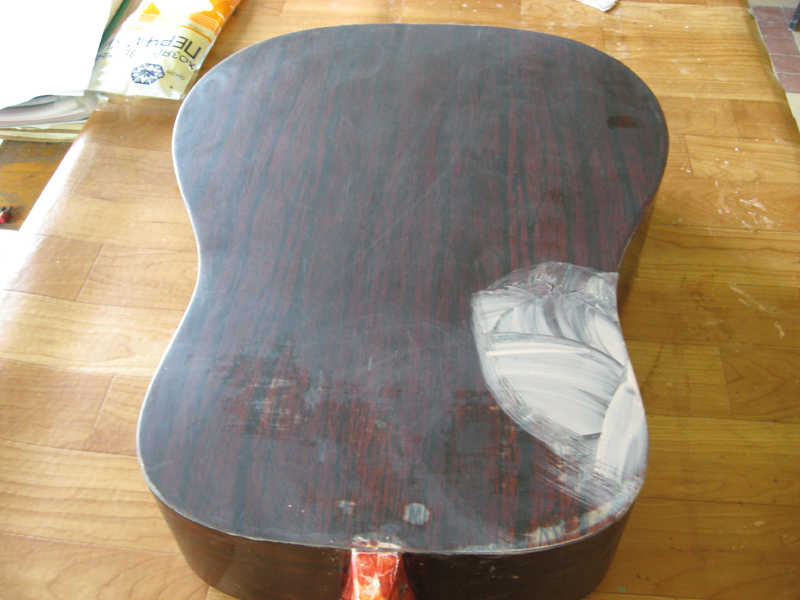
Useful tips on how to apply water-based wood varnish
13. All water-based varnishes usually have a gradual increase in hardness. Increases sticking resistance. Therefore, in no case should you stack products one on top of the other.
And even more so in the first few days. If you still stack products, then use at least polyethylene gaskets.
14. Do not apply water varnish on a dirty or greasy surface. Yuvaet so that there are already greasy spots on the tree. You definitely need to get rid of them! To do this, wash them thoroughly with soapy water and let the wood dry well.
15. If necessary, lightly, not very strongly, tint the tree. For example, to give it a noble shade, then apply a tinting impregnation on it and then, on top, apply either a colorless varnish, or a varnish with an impregnation added to it (no more than 5%). After all, any mixing can lead to swelling of the surface or its delamination.
16. When we apply tinted varnish, it is very important to monitor the uniformity of the layer thickness. If we apply a thicker layer, then getting on the edge of the product or on the joints, it will always give more dark shade. And this is worth considering. Although in some works it is this feature that gives the strongest artistic effect.
17. Tinted varnish is best applied by spray. If not, then a swab. This allows you to get very thin layers, a more uniform thickness, and a brush or roller does not give such a uniform color.
18. If we want to have a surface that is more uniform in color. Then you should not apply varnish in one layer. This effect will give several thin, smooth layers of tinted varnish.
19. If you want to give a visual effect of greater thickness and greater depth of color. This effect is achieved by applying a dark bottom layer of tinted varnish. And on top of it - colorless or very light, slightly tinted.
20. If your product has already been painted with tinted varnish and has “bald spots”. The last coating may also turn out to be uneven and darker or lighter areas will appear on it. Let's see how to avoid this defect. First, you need to completely sand the previous layer of varnish. And only then paint the cleaned wood. You can, however, apply a tinted varnish of a dark palette. It also helps to remove defects.
21. Sometimes when painting a surface with tinted varnish, if it has already been varnished with colorless varnish, the effect of “bald spots” is also observed. In this case, there is no varnish layer on some parts of the product. It is necessary to prime the entire surface twice with colorless impregnation or a layer of colorless varnish. And then onto this primed surface.
Now let's roll up our sleeves and start putting all these tips into action.
Have you already chosen the color in which you will paint your products? If not, then I suggest you read what colors are in fashion now. This is written in the article. .
Tired? Yes, it often happens in the spring. But you can try to correct your condition with color therapy. Now there is even color treatment.
Tell, ? And you try! Personally, I lack energy all the time. And I always wear a bright red scarf. And it helps.
In any case, spring is wonderful! The sun and the hope of a quick vacation warm the soul and fill the heart with joy. In the meantime, get to work!
If you do not agree with something, then even more so - write.
Acrylic water-based varnishes for wood have become widespread not so long ago, and immediately gained wide popularity. The reason for this: paints and varnishes (LKM) with the addition of water and acrylic have a number of advantages in comparison with other types of varnish.
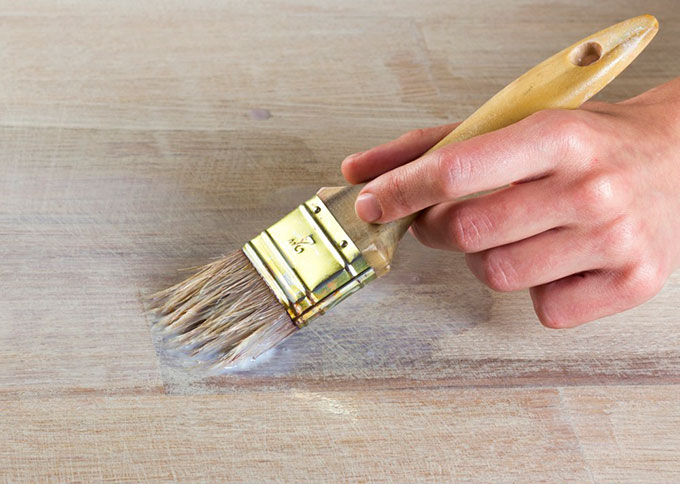 Acrylic water-based varnish is environmentally friendly and almost odorless
Acrylic water-based varnish is environmentally friendly and almost odorless Components of acrylic lacquer
Water-based acrylic varnish is a mixture of water, a binder and additives. All components are redistributed in water evenly - in small drops - with the help of a stirrer operating at high speed.
The production process is similar to dough kneading: a binder and emulsifiers are placed in water. Next, stirring begins, until the moment when the mass becomes homogeneous. A solvent may then be added to act as a film former. Precisely the presence of a film is one of characteristic features acrylic coatings. First of all, water dries, then the film-forming composition. The binder dries last.
The composition of the paintwork material includes the following substances:
- liquid polymer (acrylic dispersion);
- wood preservative;
- plasticizer - a substance that gives the varnish plasticity and elasticity;
- solvents (not always contained, but if they are, their proportion can be from 5 to 15%);
Acrylic varnishes can be produced in two versions:
- one-component, where only acrylic is present;
- two-component, in addition to acrylic, polyurethane is added.
Note! To preserve the properties of paintwork materials, the room must be heated.
Two-component varnishes are characterized by higher consumer properties. Polyurethane gives the surface the ability to resist some harmful influences, such as increased loads, spilled alcohol or household chemicals.
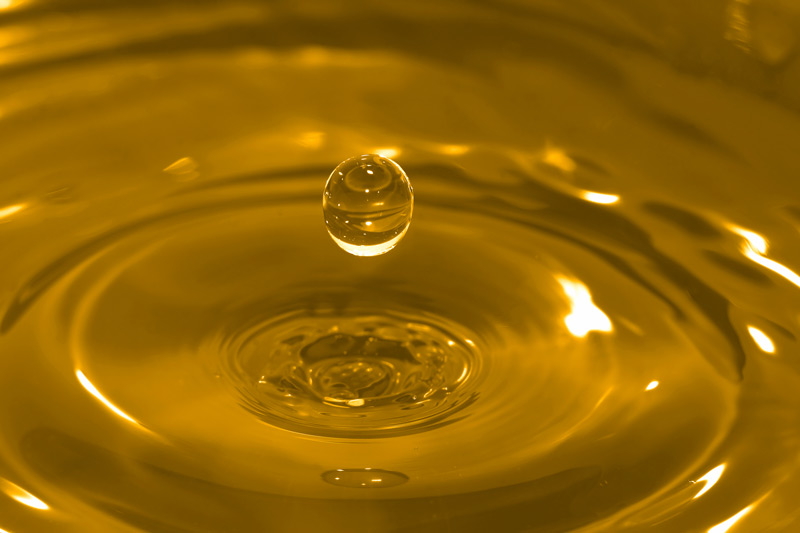 The basis of acrylic varnishes is a liquid polymer
The basis of acrylic varnishes is a liquid polymer Advantages
Acrylic-based coatings have a wide list of positive characteristics:
- resistance to mechanical influences - scratches, friction, loads;
- moisture resistance (when added to the composition of polyurethane);
- resistance to household chemicals and alcohol-containing substances;
- good adhesion and spreadability;
- thermal stability;
- fire safety;
- normal thermal conductivity;
- fast drying;
- moderate, barely perceptible odor;
- environmental friendliness;
- resistance to mold and all kinds of microorganisms;
- compliance with regulatory standards in terms of "Safety of toys", which means that acrylic varnish can be used in children's rooms;
- good leveling, preservation of the natural color of the tree, without darkening it;
- the absence of stains (due to the presence of tannin in the composition of the inhibitor), which appear under the action of resins and tannins in wood;
- resistance to ultraviolet rays, which are not able to make the varnish film turn yellow;
- attractive appearance;
- ease of application to the surface;
- good contact with clean surfaces during application;
- miscibility with ;
- water solubility is maintained until the moment of drying;
- light weight.
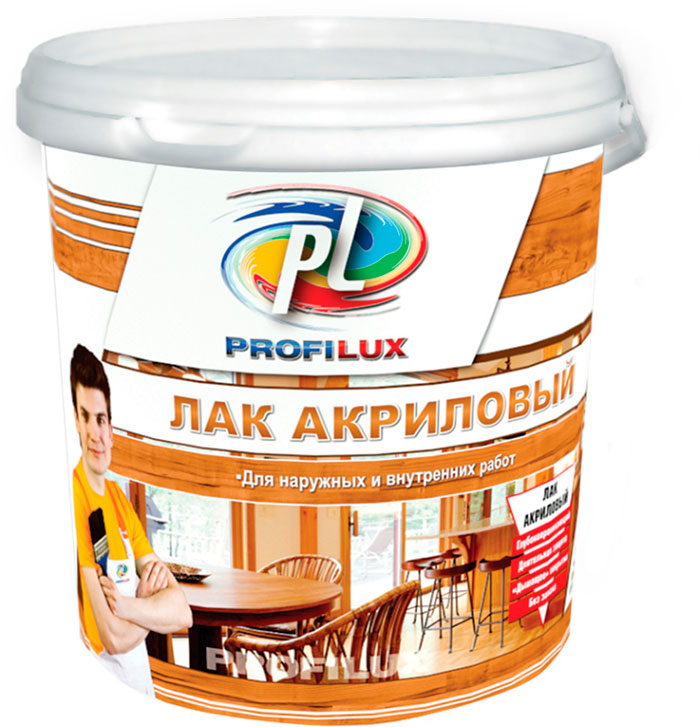 Water-based acrylic varnish is easy to use, practical and safe
Water-based acrylic varnish is easy to use, practical and safe Application features
The water-based varnish can be used not only for the treatment of wooden floors (parquet or solid wood), but also for the varnishing of other wood structures, such as doors and windows. The only limitation is that it is necessary to withstand the temperature regime (from 18 to 20 degrees Celsius) and humidity (up to 50%).
Note! If the temperature is too low, the varnish dries much longer and with less efficiency. If there is low power in the room, you can correct the situation with a humidifier, decorative flowers, or other available methods. Excessively dry air will lead to too rapid drying and surface defects.
Instructions for varnishing wooden surfaces
If the wood has been previously varnished, the old layer of varnish must be removed. This can be done in several ways: using a chemical composition, mechanical (manually or with a grinder) or thermal (building hair dryer) methods.
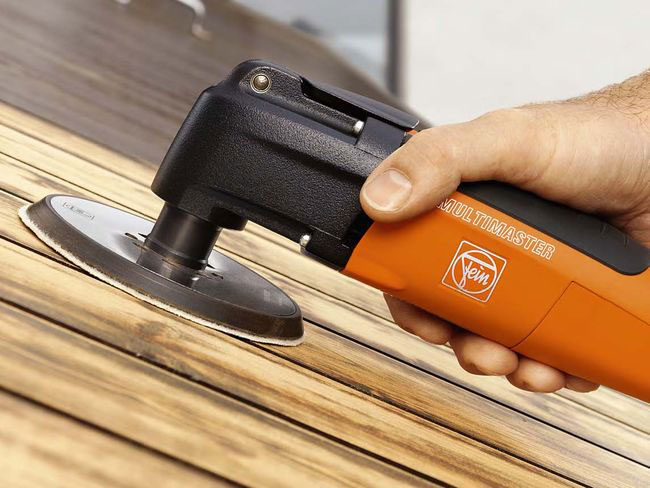 Using a grinder with a special disc, you can quickly remove the old layer of varnish from the surface
Using a grinder with a special disc, you can quickly remove the old layer of varnish from the surface After removing the varnish, the floors should be cleaned with soapy water and allowed to dry. However, it is too early to varnish the floors, first you need to prime the surface - the so-called base. Usually the primer is sold in the same place as the paintwork. Experts recommend applying at least two coats of primer.
Acrylic varnish is also applied in several layers - sometimes their number can reach up to 5-8. This indicator depends on the thickness of the varnish layer, the quality characteristics of the paintwork materials, as well as the planned strength of the coating. Acrylic varnish for wooden surfaces, like all other types of water-based coatings, is recommended to be applied with rollers.
- Shake and mix well before use.
- Do not add a solvent to the finished composition - only water.
- Acrylic varnishes can be matte or glossy.
- Before varnishing, it is advisable to check the compatibility of a particular paintwork with a coating. You can do this somewhere in an inconspicuous place, for example, under furniture.
- High-quality drying is impossible with drafts or direct sunlight.
- In the late stage of drying, when the varnish seems already dry, it is better to walk on the floor in soft shoes or socks.
- To prevent damage to the surface, felt pads should be put on the legs of the furniture.
- To eliminate the formation of bubbles or defects, the penultimate layer should be lightly sanded or sanded. Next, you need to apply one or two layers of varnish on top.
- The technology implies the application of each subsequent layer no earlier than 12 hours later. If the room temperature is too low or the humidity is high, the drying time should be increased.
- If the goal is to achieve decorative effect, the most proven method is to apply two layers of varnish on a primed surface.
- Protective goggles and gloves should be used when working with paintwork materials.
- Acrylic lacquer should be stored in closed original packaging. Optimum temperature: from 5 to 30 degrees Celsius.
A large number of companies, both Russian and Western, are represented on the market. Choosing a specific brand acrylic lacquer for wood often depends on the commitment to one or another manufacturer or on the price of the goods.
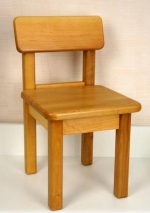
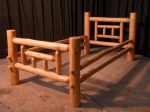
[ Click on photo
for increase ]
When using a water-based varnish for wood, you can get an excellent finish. The main condition is compliance with the requirements for the application and use of this substance.
Description
Water-based varnish for wood is a special category of varnishes, environmentally friendly. Basically, these are dispersions that are obtained by combining emulsifiers, microscopic droplets of a binder, and water. They are mixed until completely combined at high speed, until the mixture becomes homogeneous. Then some solvent is added to it.
See also: protect wood from decay What you need to know in order to protect the tree from decay? The higher the humidity of the material and air, the more active the vital activity of fungi
The drying process of water-based wood varnish differs from varnishes with a high content of soluble substances. Initially, water evaporates, after which the film-forming component with the evaporation of water becomes denser until the final setting and a strong viscoelastic film remains on the surface.
By the amount of solvents added to the mixture, water-based wood varnish can be of three categories:
- Varnish without solvents.
- Lacquer, the content of solvents in which reaches five percent.
- Fifteen percent solvents in varnish.
Application
Lacquer is applied at temperatures above 15°C. Do not allow the varnish to freeze during storage.
When applied to the surface of a water-based wood varnish, the release of solvent vapors into the air will be negligible, so it can be used in rooms where it is impossible to completely limit the presence of people. Such a varnish can also be used in conditions of increased fire hazard, since it is not combustible.
At the same time, water-based varnish for wood cannot be applied to constantly used surfaces - it is not wear-resistant. Manufacturers, seeking to improve this characteristic, add various special additives to the mixture: polyurethane-acrylic dispersion, modified dispersion (polyurethane, on fatty acids).
See also: Silicone sealant: specifications. Sealants are used for sealing seams and joints, they have high elasticity, waterproofing, resistance to fluctuations and temperature changes, durability, protect surfaces from UV rays, vibrations and deformations, excellent adhesion
Indoor air humidity should be at least fifty percent, which is not always possible to ensure, therefore, the scope of water-based varnish for wood is significantly reduced. The only possible way out is an artificial increase in humidity.
As a rule, rollers are used for work. Water-based varnish applied with a brush or swab will not completely “open” on the surface. It is also undesirable to apply varnish without a primer.
Do not apply water varnish on oily or dirty surfaces. It happens that there are already greasy spots on the tree. It is imperative to get rid of them. To do this, rinse them thoroughly with soapy water and allow the wood to dry well.
Natural wood has many excellent properties, but various external factors have a destructive effect on it: humidity, temperature changes, microorganisms, etc. To ensure its durability, it is necessary to use special protective compounds with effective action.
Wood preservatives
To protect wood from premature destruction, modern builders have a number of compounds in their arsenal that increase its durability and increase resistance to adverse external factors. For this purpose, various means are used: varnishes and impregnations for wood, antiseptics, flame retardants and fungicides.
Impregnation for wood
Impregnation for wood is applied to a clean, dry surface to protect the top layer from the destructive action of microorganisms and insects. Active substances penetrate deep enough into the thickness of wood fibers, creating an insurmountable barrier for biological destroyers. Often, wood stains give it various shades that improve the appearance of the surface and imitate valuable wood species.
Water-based stains are available, as well as those based on organic solvents. Both those and others penetrate the wood to a depth of 3 mm, the difference between them lies in the drying speed. Water compositions dry for 3-4 hours. For organic solvents, depending on the type of base, drying lasts from several minutes to 24 hours.
Varnishes for wood
Lacquer for wood for interior use forms a protective water- and air-tight film. It can be colorless or give the tree a certain shade. Like impregnations, varnishes can be water-based or organic-based. Water-based varnishes are environmentally safer, but their complete curing takes a long time - up to 10 days. Acrylic varnish, which is traditionally used to coat parquet, dries faster - in about 4 days.
Wood coatings, which can be bought at the Leroy Merlin store, will reliably protect the house, providing the wood with high durability and excellent appearance.









